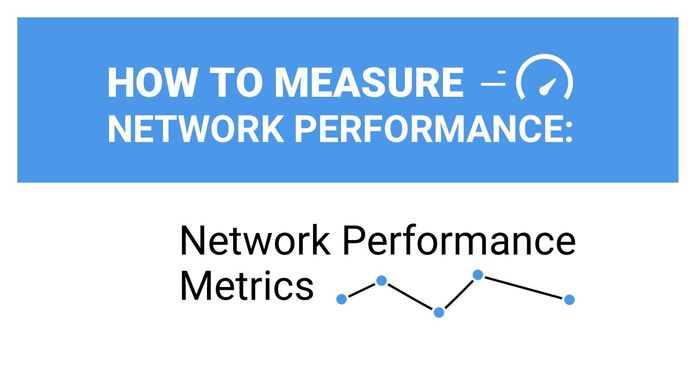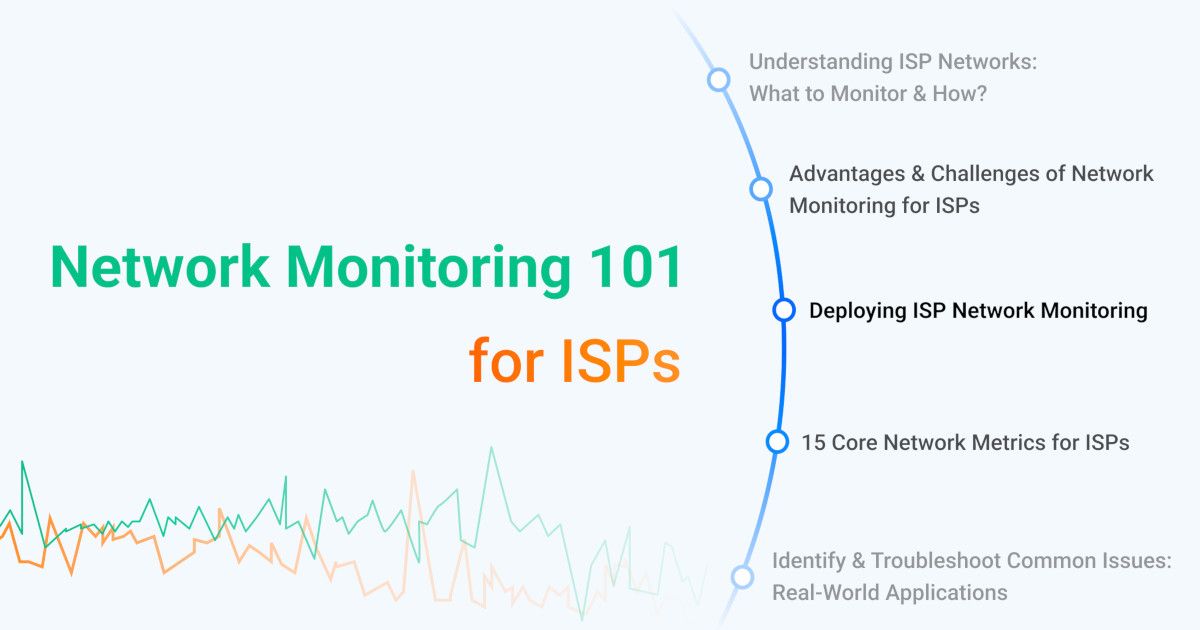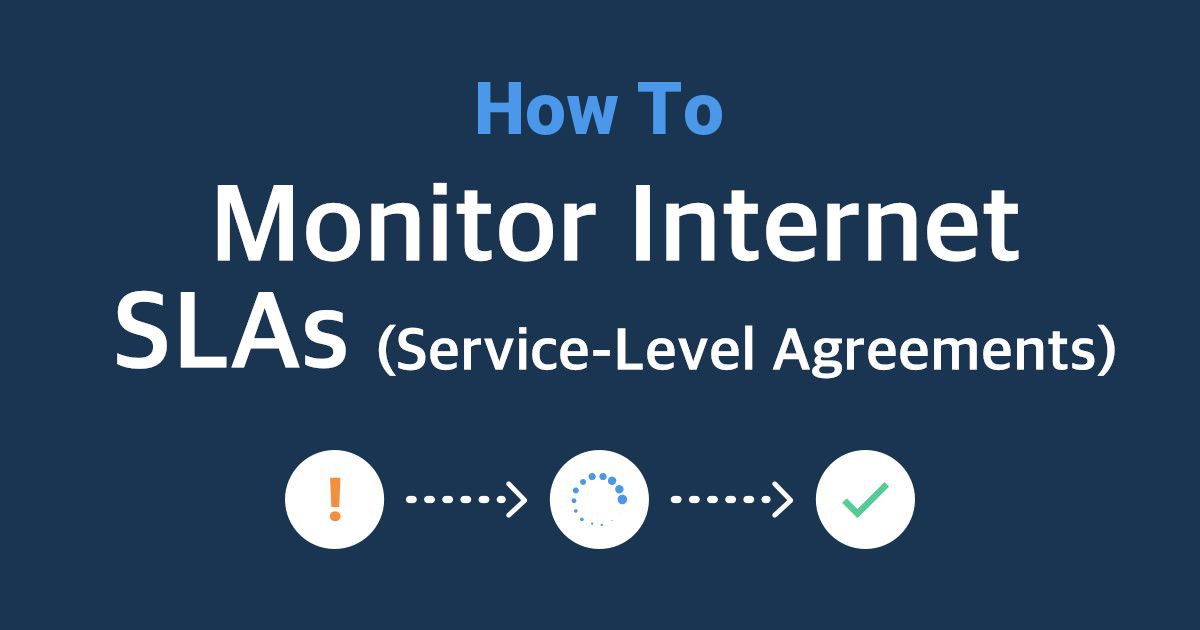Table of Contents
Table of Contents
In the vast landscape of connectivity, Internet Service Providers (ISPs) serve as the architects behind the intricate web that links residential users and businesses to the global digital realm. ISP networks are a sophisticated combination of technologies and infrastructure that require efficient management from administrators for maximum value for all parties involved.
This article delves into the essential components of an ISP network, the vital importance of efficiently monitoring ISP performance, and a detailed guide on setting up a robust ISP performance monitoring system and strategy.
The Internet's backbone, or ISP networks, creates a complex technological web that links end users to the rest of the globe. Put more simply, these networks include all of the technologies and infrastructure Internet Providers use to connect their customers to the broad world of the Internet.
Here's a closer look at the components of an ISP network:
Infrastructure: Internet service providers take pride in having a network infrastructure that combines wired (coaxial and fibre optic cables) and wireless (satellite, Wi-Fi, and cellular) technology. This infrastructure is carefully designed to transport data from the ISP hub to end users.
Data Centers: Customers access a wide range of online content, apps, and services using servers and networking equipment located at the hubs of Internet service providers. These centers also handle crucial functions including traffic control, routing, and storing.
Peering and Transit: Through peering and transit agreements, ISPs dance with one another in a complex manner. Through peering, traffic is directly exchanged between ISPs without including any money exchanges. In contrast, ISPs pay larger providers for a gateway to the wider Internet through Transit.
Routing and Switching: ISP networks use routers and switches to maintain a smooth flow of data. While switches enable data transfer within a network, routers determine the best route for data to take while moving across networks.
Customer Premises Equipment (CPE): ISPs provide their clients with the gear they need to explore the internet. Modems, routers, and other equipment that enable users to connect and access the ISP's network may fall under this category.
Service Plans: To meet the various needs of its customers, ISPs offer a variety of service plans. There are differences between these plans in terms of extra services, data caps, and speed. ISPs typically offer DSL, cable, fibre-optic, and wireless Internet connections (such as cellular and Wi-Fi).


There are various reasons why ISP performance monitoring is important. It is an essential part of network management that helps businesses maximize network efficiency, reduce downtime, and guarantee network security and compliance.
The following are some of the main justifications for why ISP network monitoring is crucial:
1. Boost ISP Network Performance: The primary reason for having a high-performing network is that ISP performance monitoring is necessary to keep it that way. It enables you to locate problems and resolve them, thus enhancing network efficiency.
2. Proactively Identify ISP Network Problems: Network issues can and do arise, and they can significantly affect operations. These issues can include performance concerns as well as availability issues. Therefore, it's critical to proactively detect any network problems before they become disastrous:
- Availability Problems: A total loss of connectivity is the hallmark of availability problems. Fibre cuts, power outages, and physical damage to network infrastructure are just a few of the causes of these network failures. Even though availability problems are detrimental to ISP network dependability, they are also the simplest to identify and resolve.
- Performance Problems: Identifying and resolving ISP network performance problems is more difficult than availability problems. These malfunctions can be intermittent or constant, with the latter being the hardest to locate and diagnose. Anywhere can have performance problems, and they could go years without being noticed.
3. Optimize End-User Experience: Keep an eye on how users are feeling when utilizing network apps and services. Proactively detect and fix issues with the network before they become annoying to users.
Focus on:
- Providing quicker assistance for end-user problems.
- Boosting customer satisfaction
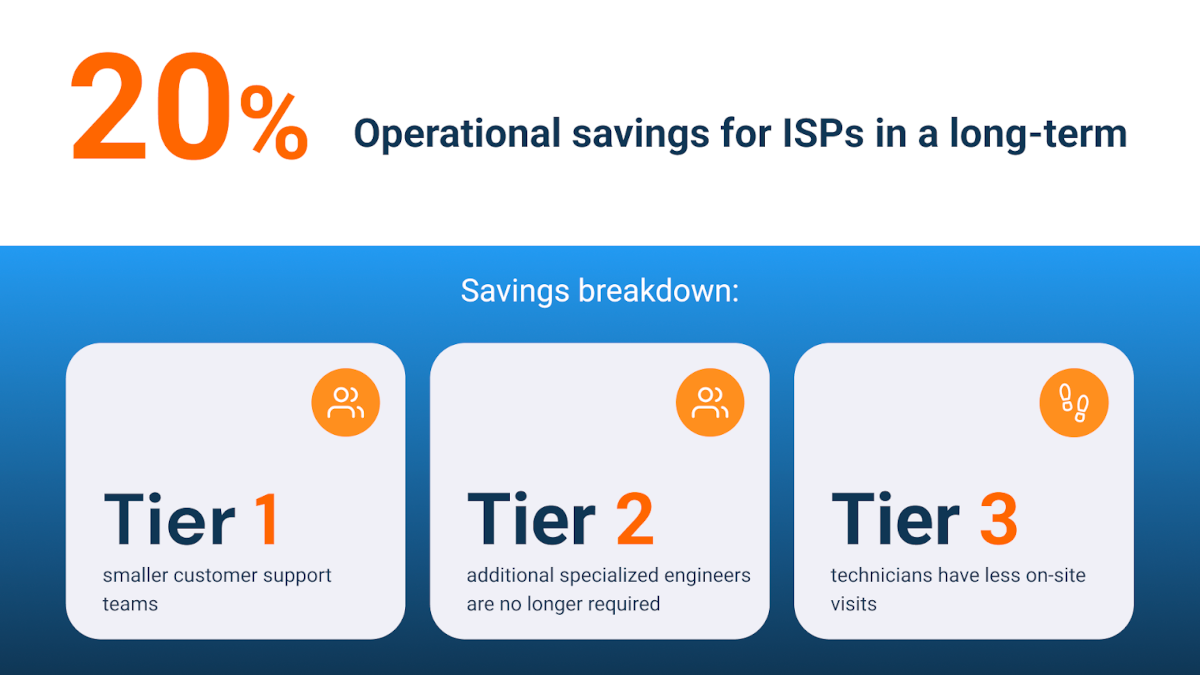
4. Enhanced ISP Network Security: Enhanced network security by the detection of possible security risks, like anomalous network behaviour or unapproved entry attempts.
- Find possible security lapses
- Reduce the possibility of losing data
- Boost compliance with rules and industry norms
5. Capacity Planning and ISP Network Optimization: By examining network traffic and resource usage, network admins can spot possible bottlenecks to:
- Organize capacity expansions to accommodate anticipated increases.
- Enhance network efficiency to meet growing needs.
- Lowering future infrastructure costs
6. Reduced Costs and Enhanced ROI: By locating inefficiencies and maximizing network resources, ISP performance monitoring can assist in reducing costs and enhancing ROI.
- Make changes to locations where resources are either abused or underused.
- Make sure the network is operating at optimal efficiency to maximize return on investment. This can boost output and user happiness.
- Cut down on the expenses related to unforeseen outages and network outages.
7. Solid ISP Business Continuity: Better network performance and user experience will have a beneficial overall impact: on your ISP business:
- Reduce service interruptions and downtime that impact productivity.
- Prevent performance problems and network outages, which can cost companies money and effort.
- Resolve network problems quickly and without additional IT resources
8. Create a Solid Ground for Growth: In a cutthroat market, where favourable word-of-mouth acts as a growth engine, happy clients not only stay with you but also act as brand ambassadors.
For business owners, ISP performance monitoring is a strategic asset and a technical need. It serves as the cornerstone for building a happy clientele that voluntarily refers friends, family, and business associates to your services.
Discover the unparalleled benefits of ISP Performance Monitoring with the premier tool in the market!
Explore the advantages of utilizing Obkio's Network Monitoring software, specifically designed to cater to a variety of ISP network structures. Our intuitive interface ensures a quick and effortless setup process.
Pinpoint and resolve issues, gain immediate visibility into the performance of your ISP network, and empower your corporate clients by equipping them with the tools necessary to independently manage and troubleshoot their network using Obkio.

- 14-day free trial of all premium features
- Monitor performance in all key network locations
- Measure real-time network metrics
- Identify and troubleshoot live network problems
With just 10 minutes to spare for deployment, Obkio lets you immediately begin to monitor ISP performance!

Understanding your infrastructure is crucial before implementing ISP performance monitoring. It allows you to tailor the monitoring strategy to the specific components and characteristics of your network, ensuring accurate and relevant insights. Knowing your infrastructure helps identify critical points, potential bottlenecks, and areas where performance improvements are needed.
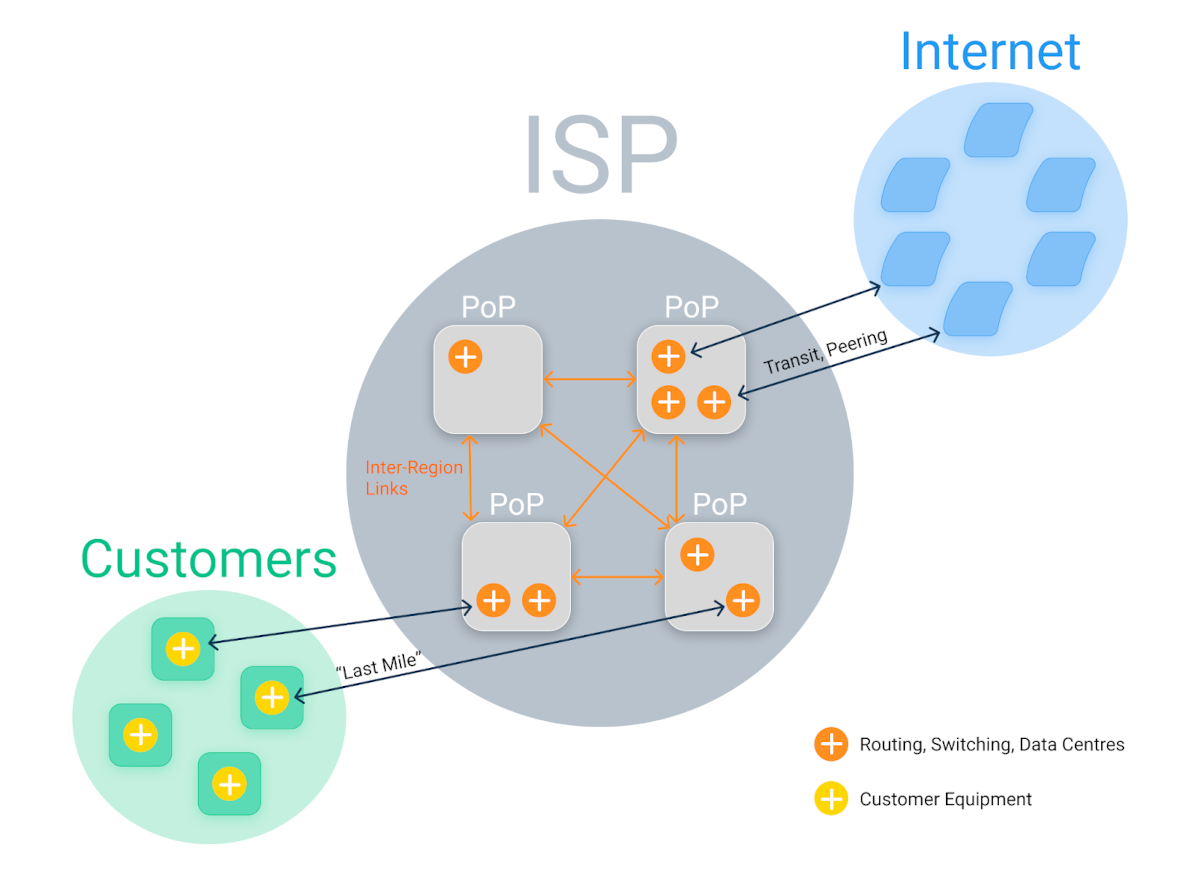
Let's examine the essential elements of ISP networks in more detail and discuss the benefits of keeping an eye on them.
- Subscriber Equipment: Customers use given equipment, like a modem or router, to connect to the Internet service provider's network.
- Access Technologies: To create a link between the customer's location and the ISP's network, the access technologies that the ISP uses are DSL, cable, fibre-optic, and wireless.
- Data Delivery to End Users: At last, the link between the Internet service provider and the end user is completed when data arrives at its intended location, which could be a website, an application, or another user.
Tracking client connections enables the identification of issues including equipment breakdowns, signal strength issues, and connectivity problems that are specific to unique user experiences. A good service experience and overall customer satisfaction are enhanced by promptly detecting and resolving client connection problems.
- “Last Mile” link: The link between the customer's location and the closest point of presence (PoP) in the ISP's network is referred to as the "last mile," via which the data passes.
- Local Loop: To get to the ISP's headend, or central office, data via wired connections, such as DSL or cable, passes over a local loop of wires.
It is possible to detect any bottlenecks, signal deterioration, or outages in the last-mile connection by keeping an eye on the local network infrastructure. By doing so, ISPs can minimize downtime and guarantee constant service quality by quickly identifying and resolving local network issues.
- Central Office/Headend: The data from different local connections is combined and processed at the central office or headend. The basic network of the ISP starts here.
- Routing and Switching: By figuring out the optimum routes for data to take to reach its destination, routers and switches control the flow of data within the ISP's network.
To locate and resolve problems with data aggregation, routing mistakes, or equipment malfunctions in the central office or headend, it is imperative to keep an eye on the central infrastructure. In doing so, massive service disruptions are avoided and network stability is preserved by ISPs.
- Backbone Infrastructure: The core network is made up of high-capacity backbone connections that connect various ISP network segments, frequently via fibre-optic cables.
- Peering and Transit: To exchange and route data throughout the larger Internet, the ISP establishes connections with other ISPs via peering and transit arrangements.
Constantly keeping an eye on the core network makes it easier to spot issues like equipment failures, congestion, and unusual routing that could compromise the backbone of the ISP.
Exchange of Traffic: ISPs often connect to Internet Exchange Points, where they can exchange traffic directly with other ISPs. This helps in more efficient and direct routing of data.
Monitoring traffic at IXPs helps ensure efficient and reliable data exchange between ISPs to identify potential congestion points and connectivity issues, therefore improving overall Internet connectivity for their customers.
- Transit Providers: They assist in getting data to its final destination on the Internet for areas outside of the ISP's network.
- DNSs, or Content Delivery Networks: To lower latency and accelerate content delivery, popular content is frequently stored in content delivery networks (CDNs) and distributed internationally.
By keeping an eye on CDNs and transit providers, one can detect problems with data transit and make sure that traffic going to external networks arrives at its destination with reliability. This can reduce latency and enhance user experience by optimizing external network connectivity.
ISPs maintain and enhance their networks during this process to give customers a reliable and efficient Internet experience. Users only see the advantages of having access to the enormous universe of Internet services and information, they are unaware of the intricacy of the ISP network.

Monitoring ISP performance is more straightforward than you might think. By following the considerations outlined below, you'll smoothly navigate through potential obstacles, avoiding bumpy roads and pitfalls on your way:
Selecting the best network performance monitoring tool can be difficult, especially with the variety of solutions that are now on the market. During the purchasing process, a number of elements need to be carefully considered, including the goals, requirements, budget, and use case for network monitoring in your company.
- Determine the use case for your ISP performance monitoring.
- Perform an assessment of the ISP network.
- Choose the desired network location for increased visibility.
- Try several options (3-5 different vendors) to get the best possible purchase process decision.
- Create a budget and make sure staff has the time to finish the test.
- To get a complete picture of the network, make sure the ISP network performance monitoring tool is integrated with other network management tools in your arsenal.
- Make sure that ISP network monitoring software can scale to cover the growing network architecture (prompt for software development companies rather than open-source network monitoring solutions).
Confidently navigate the network monitoring tools landscape with our ultimate buyer's guide. Expert insights, use cases, and tips for informed choice
Learn more

Following the selection of an ISP performance monitoring tool, it must be put to the test through a POC and put into use. The POC verifies the tool's usefulness and functionality in a practical environment, and the implementation process guarantees its proper configuration and integration with the current network infrastructure.
The most important factors and recommended procedures for carrying out a fruitful POC and putting in place an ISP performance monitoring software:
- Implement the ISP network performance monitoring solution in line with your use case.
- Examine data, then respond to identified events to resolve issues within the network.
- Check to see if the anticipated results have been achieved.
- Verify the report on time spent and outcomes achieved, as well as the ease of use.
- Examine the outcomes of several ISP network monitoring tools and select the best one.
- Invest in the best ISP network performance monitoring.
To make sure an ISP performance monitoring tool provides the desired results, it's critical to keep an eye on and optimize its performance after you've invested in and put it into use. To make sure the tool continues to be effective in fulfilling the changing needs of the network, the post-purchasing process entails constant monitoring, analysis, and maintenance.
- When the solution is fully deployed, grant access to and onboard all IT personnel.
- Set up notifications and network alarms to react swiftly to network problems.
- Examine and evaluate network performance data regularly to spot patterns and possible problems.
- Update the ISP network performance monitoring tool frequently to make sure it has the newest features and technologies.
- Use security best practices to prevent unauthorized access and data breaches from occurring with the ISP performance monitoring tool.
- To identify and resolve network problems instantly, keep an eye on the network at all times and in real-time.
Begin your journey with Obkio now, and proactively address network issues before they disrupt your operations. Our platform offers various network monitoring features to help ISPs quickly detect, diagnose, and resolve network issues before impacting their end users.
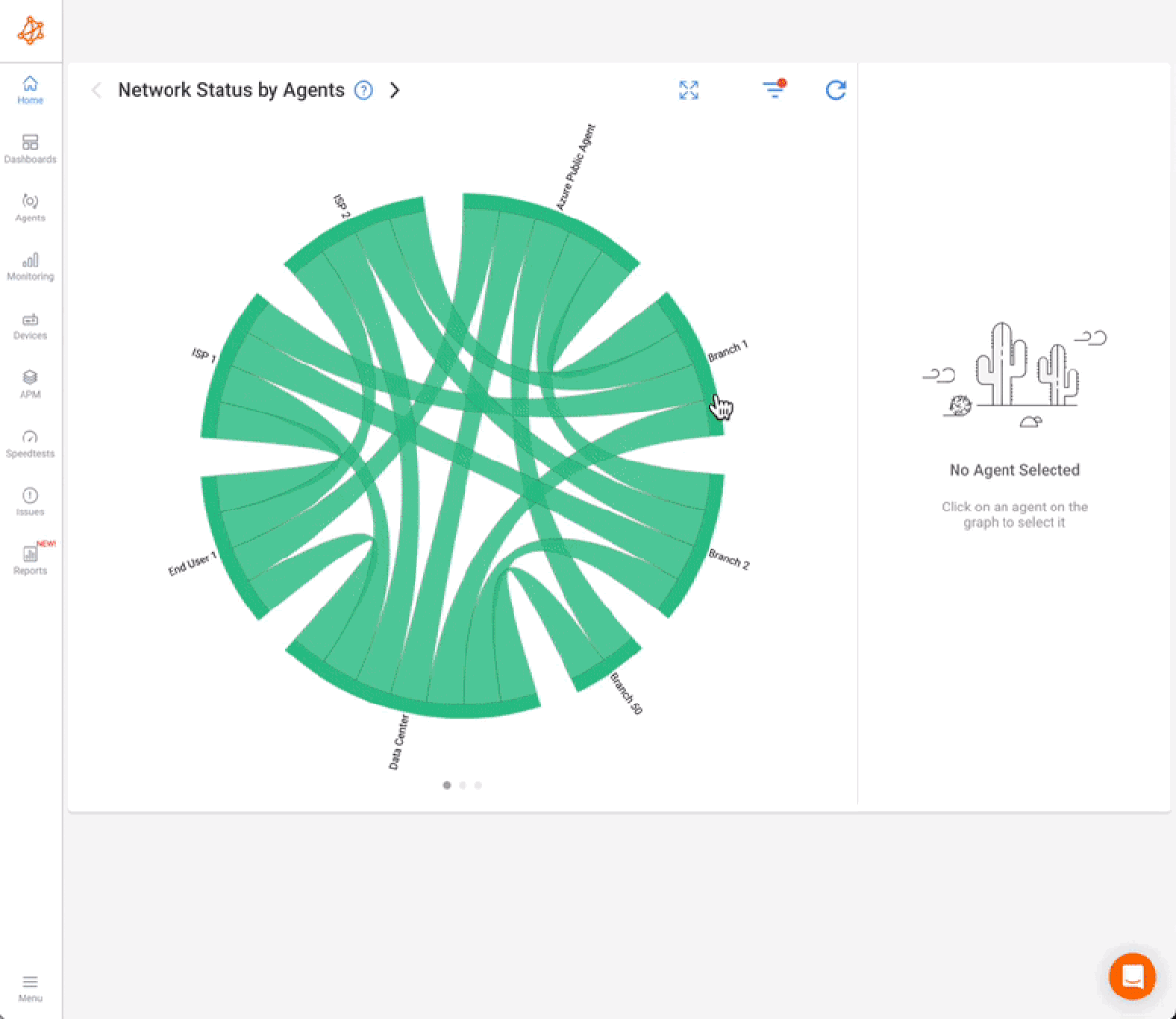
These features encompass active monitoring agents that generate synthetic traffic, network path monitoring, cloud network monitoring, ensuring seamless connectivity for all users, optimal performance of essential applications, and more.
Obkio's user-friendly interface requires minimal training, making deployment and operation straightforward.

Now it’s time to walk you through a step-by-step approach for network performance setup tailored for ISPs. Efficient configuration is crucial for cost-efficient and seamless network monitoring in future, ultimately benefiting your end-users and helping you maintain a competitive edge in the dynamic landscape of Internet services.
Monitoring Agents embedded in Obkio's ISP performance monitoring system continuously oversee network and Internet performance across the entire ISP network.
Strategically positioned, these specialized software agents are adept at detecting potential network issues spanning various platforms, applications, and the Internet. They provide a wealth of information, particularly regarding client networks, all without disrupting real user traffic.
The comprehensive monitoring extends to various network locations, including branch offices, corporate headquarters, data centers, clouds, and the Internet. By simulating traffic exchanges at a rapid rate of every 500 ms, these Agents ensure a thorough assessment of ISP performance monitoring.
Local agents, available for Windows, MacOS, Linux, and Hardware, are strategically installed in key network locations such as data centers, branch offices, and remote sites. Their primary function is to monitor and report on performance metrics.
Public monitoring agents are deployed on major service provider networks like AWS, Google, and Azure. These agents facilitate the examination of branch performance externally to the Internet, eliminating the need to route through a central office for analysis.
Additionally, some ISPs opt to host Public Monitoring Agents, allowing clients to monitor network performance seamlessly up to the ISP network infrastructure. This is made possible through the utilization of pre-deployed Agents, providing clients with a comprehensive view of their network performance.
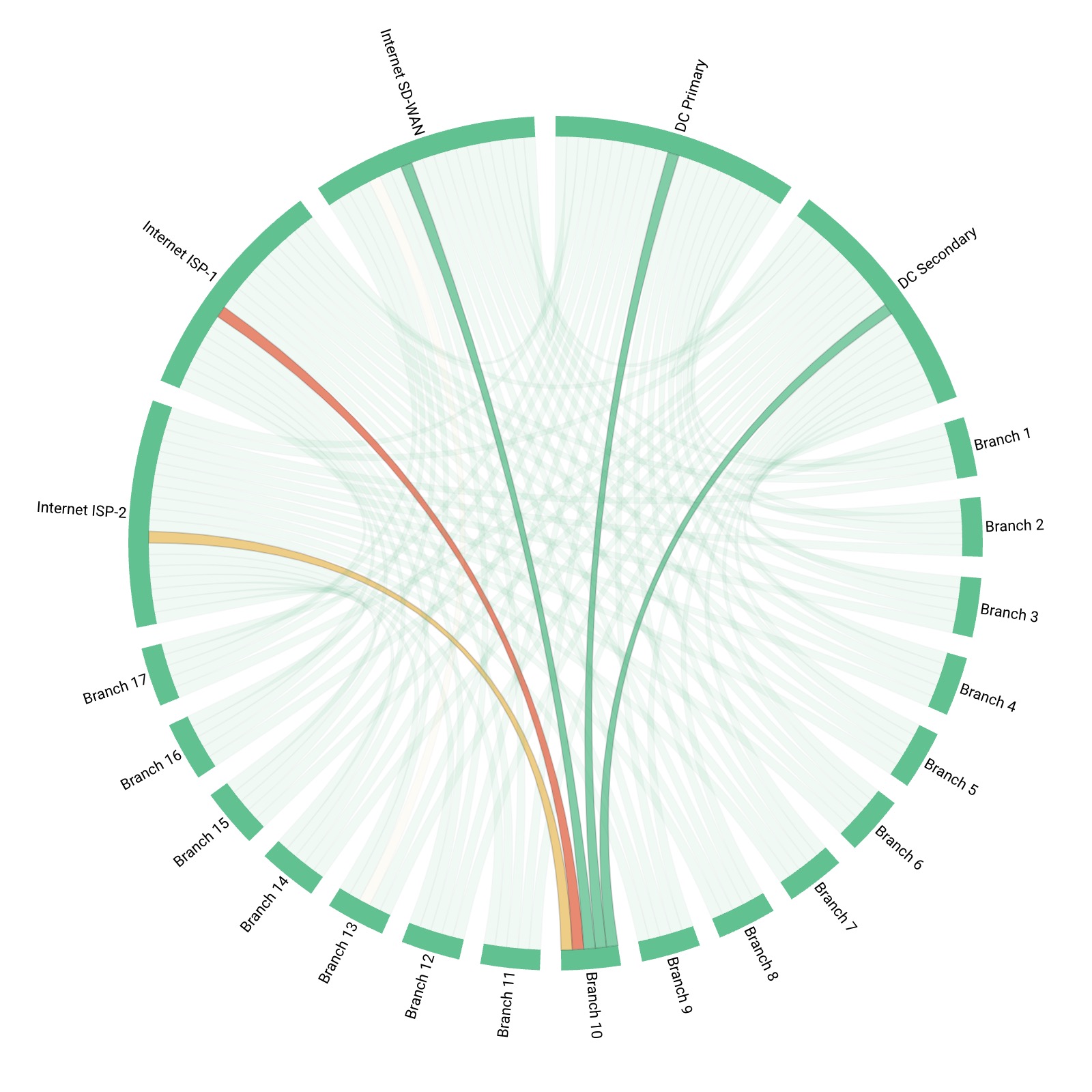
Install an agent in each Point of Presence (PoP), taking into account the infrastructure, PoP quantity, and their relative importance. Balancing cost savings with strategic placement ensures a comprehensive monitoring network.
Quick Tip: Identify short and long-term projects for performance improvement, such as adding PoPs or changing network architecture. Additionally, address saturated peering links impacting connections to Cloud Providers (e.g., AWS or Azure).
This will prove beneficial in strategically placing agents for maximum efficiency and effectiveness, ensuring that your ISP performance monitoring is ready for the expansion of your network.
Network Performance Testing involves the systematic analysis and examination of your network through the use of performance tests. This process aims to identify potential bugs and performance issues, assess the impact of significant network changes, and gauge overall network performance.
Even the most robust ISP networks encounter issues, underscoring the importance of network testing. Therefore, it is advisable to conduct network performance tests both before and after new service migrations or deployments, the introduction of new applications or network devices, and as an ongoing practice.
Several key objectives are associated with network testing:
- Performance Evaluation: Network testing allows for the measurement of various performance aspects, including speed, throughput, latency, and bandwidth. It assesses the network's capability to handle data traffic and ensures it aligns with performance expectations.
- Reliability and Availability: Determining the network's availability and reliability is a critical aspect of network testing. This involves evaluating uptime, redundancy, network failover mechanisms, and the network's ability to recover from failures.
- Security Assessment: Security or is a paramount consideration in network testing. Security or [risk assessments](/blog/network-risk-assessments evaluating the network's vulnerability to security threats and assessing the effectiveness of security measures such as firewalls, intrusion detection systems, and encryption protocols.
- Quality of Service (QoS): QoS testing is crucial for evaluating the network's ability to prioritize and deliver various types of traffic with distinct levels of service quality. This ensures that critical applications receive the necessary bandwidth and experience low latency, which helps your ISP meet the Service Level Agreements (SLAs).
- Load Testing: Load testing entails simulating conditions of heavy traffic to understand how the network performs under peak usage. This process helps identify potential performance degradation and aids in effective network capacity planning.
To gauge the health of your network, conduct PoP-to-PoP network performance tests. Evaluate Quality of Service (QoS) marking and preservation between PoPs to ensure a seamless experience for end-users. Additionally, perform tests for PoP-to-Internet connectivity via public agents.
Prevent the inadvertent misconfiguration of QoS on a single transport or backbone link, which could result in the re-marking of all traffic to DSCP 0, thus disabling QoS for the entire network traffic. We also recommend prioritizing Microsoft Teams traffic over streaming services like Netflix for business customers. This means setting a higher DSCP score (ranging from 0 to 64) for critical applications.
PoP to VIP customers performance tests: For business customers who bring a lot of revenue to your ISP, you can deploy Obkio’s plug-and-play hardware agents to troubleshoot issues on their local networks and gain in-depth insight into their network health.
SNMP monitoring entails leveraging the Simple Network Management Protocol (SNMP) to gather and scrutinize data from network devices, aiming to monitor their status, performance, and utilization. This monitoring process comprises two key components: SNMP agents, strategically installed on network devices for data collection and transmission, and SNMP managers, responsible for receiving and processing the transmitted data.
The primary purpose of SNMP monitoring is to empower network administrators with insights into a diverse range of metrics related to network devices. These metrics include but are not limited to CPU usage, memory utilization, network traffic, and more. By consistently monitoring these metrics, administrators gain the ability to identify potential issues before they escalate to critical levels, swiftly troubleshoot problems, and optimize overall network performance.
SNMP device monitoring is versatile and can be applied to various devices, including:
- Routers
- Switches
- Firewalls
- Servers
- Wi-Fi Access Points
- And other devices equipped with SNMP capabilities
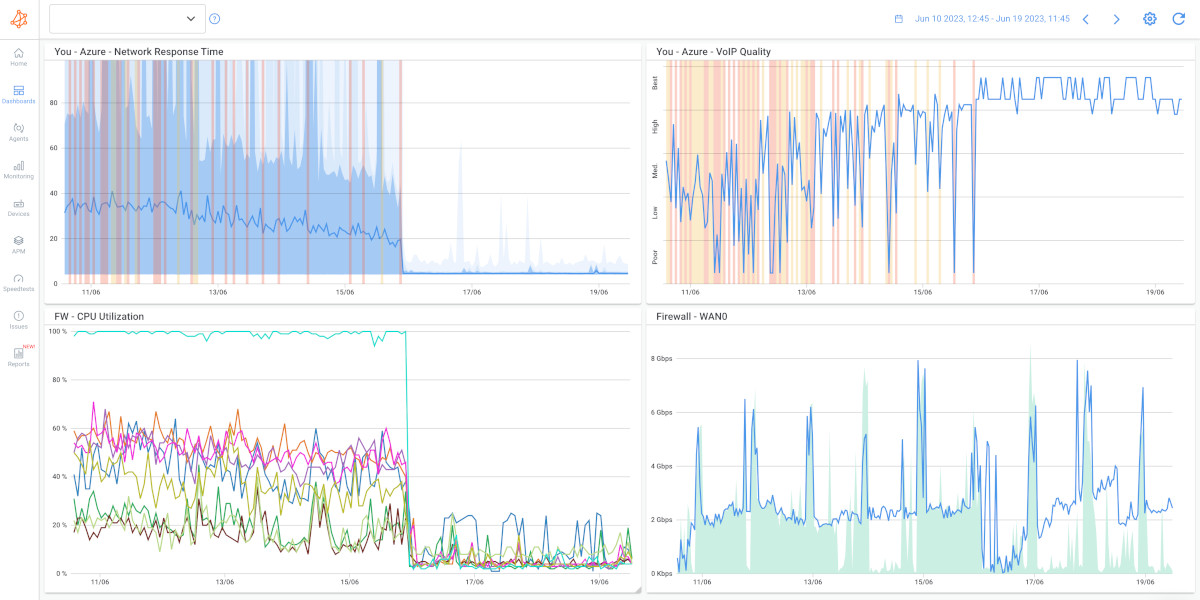
Enable SNMP on all your core equipment via local PoP Obkio agents. Focus on critical equipment within a PoP, understanding that some points may aggregate multiple functions. Align SNMP polling with the specific objectives of your performance monitoring strategy.
A network monitoring dashboard serves as a centralized hub offering real-time insights into the performance and health of your network. This platform consolidates essential metrics, data, network visualizations, providing you with the capability to efficiently monitor, analyze, and respond to network events promptly.
Creating effective dashboards is essential for gaining insights into ISP performance monitoring.
With Obkio you can develop customized network monitoring dashboards for a comprehensive view, incorporating widgets for key metrics and components.
Consider creating the following dashboard examples:
Create an overall network performance dashboard for a general understanding of the whole network's health.
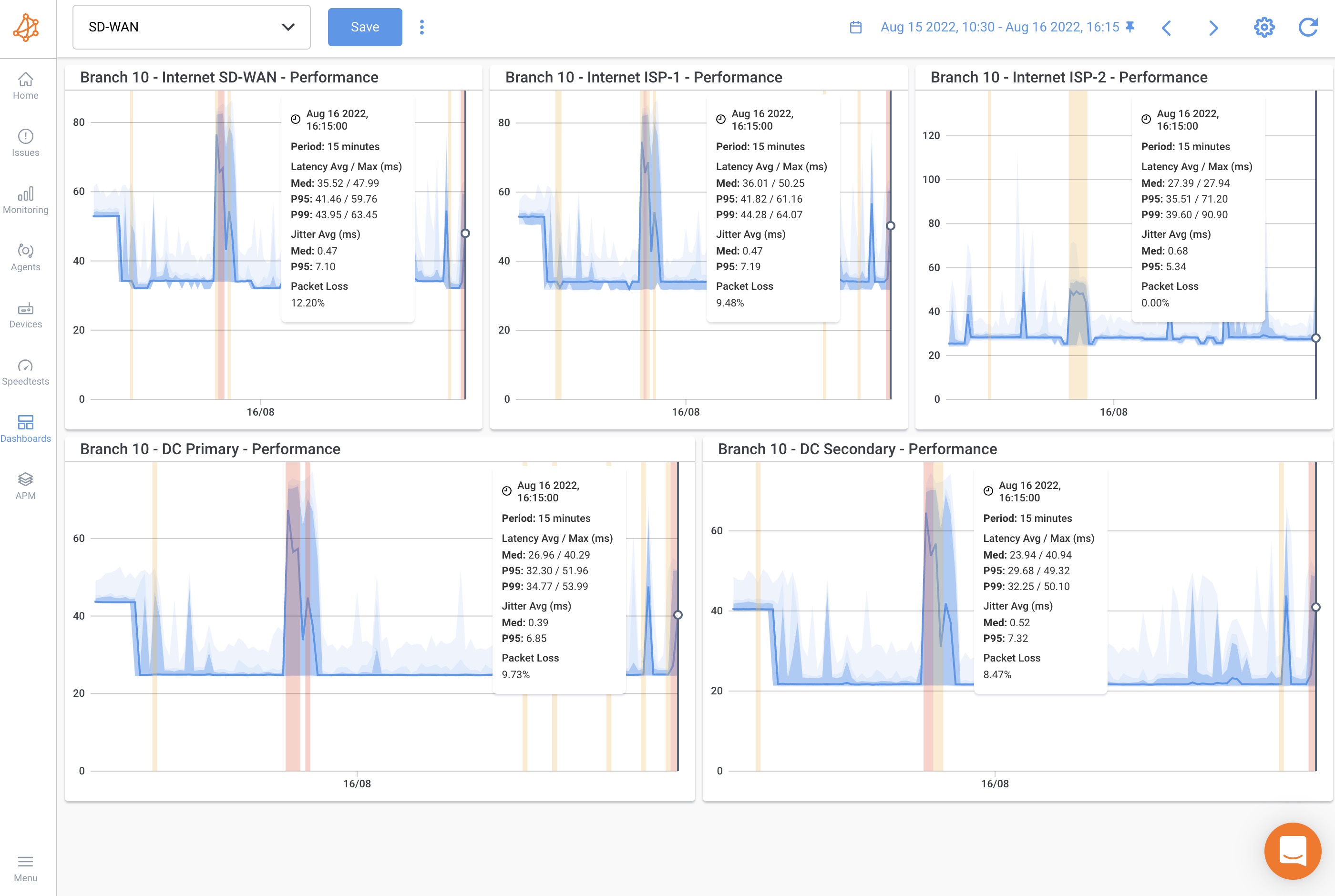
Create specific dashboards for each PoP and corporate customer, offering targeted insights and allowing for more precise troubleshooting.
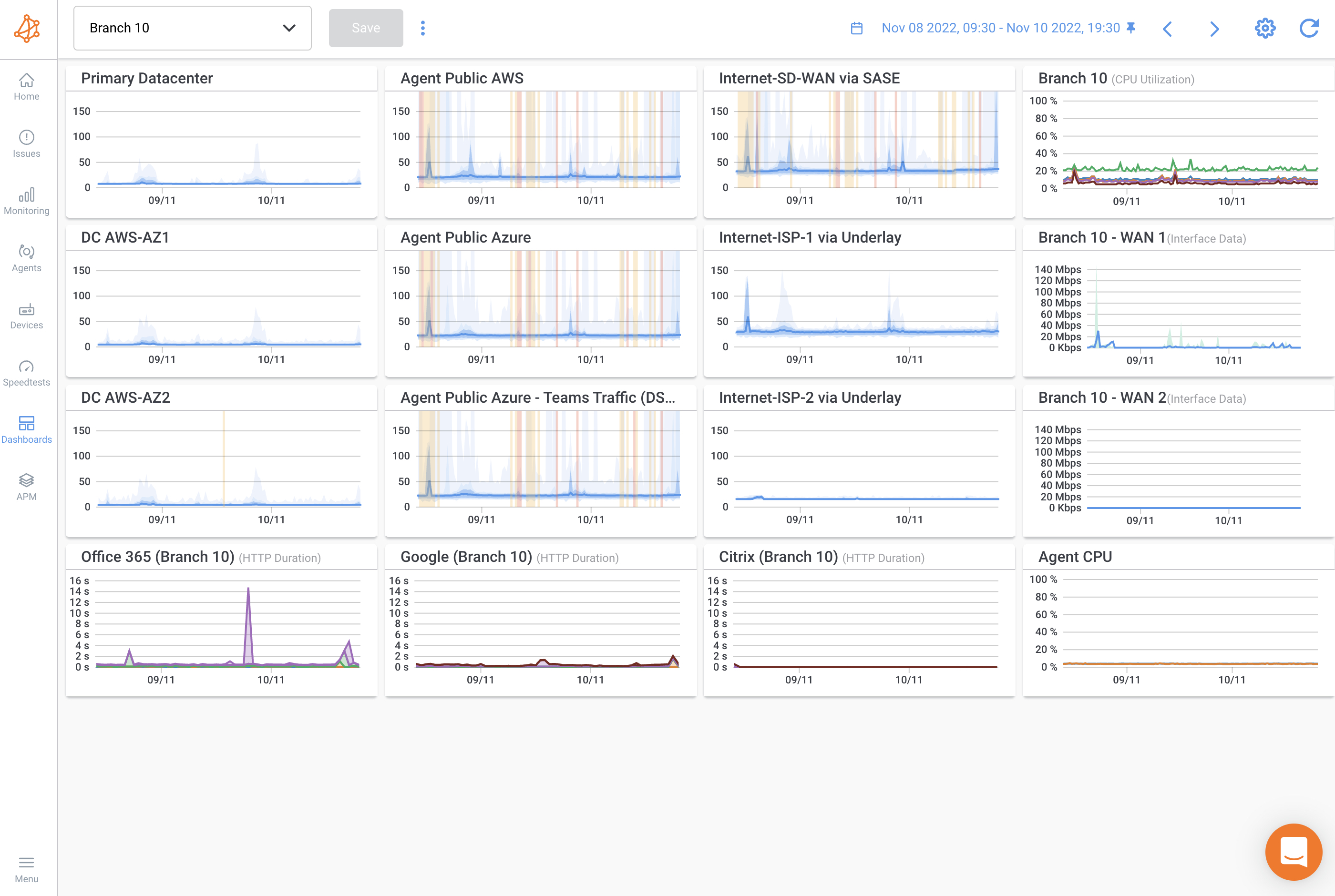
Network Monitoring Alerts function as vigilant guardians for your ISP network, consistently scrutinizing nodes to identify performance or health anomalies surpassing predetermined thresholds.
Upon detection of abnormalities, these real-time alerts promptly dispatch notifications via text, email, or other configured channels, ensuring that designated network administrators receive timely updates.
For example, a network admin sets a bandwidth usage cap of 80% for a critical interface. Should the usage exceed this predetermined threshold, an alert is triggered, immediately notifying the relevant personnel. Similarly, if CPU utilization breaches the 80% limit, an alert is generated, prompting an immediate investigation into the device or application responsible for the heightened memory usage.
A core principle underpinning the efficient utilization of ISP network monitoring alerts is their inherent need to be actionable. An alert should only be triggered if there is a specific action for a network administrator to undertake, otherwise, it should not serve as a cause for alarm. The key lies in monitoring what is truly relevant and crucial.
Quick Tip: Configure notifications with low thresholds for availability and high thresholds for performance. However, recognize that availability issues have a more immediate impact on customers. Avoid alarm fatigue from unnecessary notifications by tuning thresholds and setting appropriate delay times for notifications.

Network performance reports serve as comprehensive summaries or analyses, presenting the performance metrics and data collected from a network in a consolidated format. These reports offer valuable insights into the health, efficiency, and overall performance of an ISP network infrastructure. They provide a detailed overview of various performance indicators, including latency, packet loss, throughput, jitter, and other pertinent network parameters.
These reports often incorporate charts, graphs, tables, and other visual representations, enabling swift identification of network issues, trends, and patterns. This visual approach enhances the accessibility and clarity of information, empowering stakeholders to make informed decisions and take prompt actions to optimize network performance.
Here are some key action points for ISP network admins:
- Generate weekly email reports for all PoPs to identify outliers and potential issues.
- Assign one dedicated person to analyze reports, ensuring focused attention and prompt action.
- Regularly verify ISP network availability and performance reports to stay ahead of potential issues thus delivering a stellar experience for your customers.
Obkio’s Reports feature empowers ISP network admins to efficiently extract and analyze substantial volumes of data from the Obkio App simultaneously. With this feature, you can:
Summarize Data: There are currently four Report Types available. Users can generate reports to review network metrics, identify instances of network performance degradation, or highlight specific network issues.
Download Reports: Easily download reports using a public URL. This streamlined process eliminates the need for users to have a dedicated account created within the Obkio App for report downloads.
Share Reports: Seamlessly share reports via email with a list of designated email addresses. This functionality enables users to distribute reports to multiple contacts simultaneously.
Choose A Time-Frame: Users have the flexibility to display ISP network performance data spanning a period ranging from a few hours to a full month. This allows for customized insights into different time frames.
Schedule Reports: Schedule the generation of reports to run on a daily, weekly, or monthly basis. This automated scheduling feature ensures regular and timely access to critical network performance data. Learn more about Report Schedules for enhanced planning.
Leverage Webhooks: Harness the power of Webhooks to automate the processing of reports. This feature facilitates the seamless integration of report-related processes, enhancing efficiency.
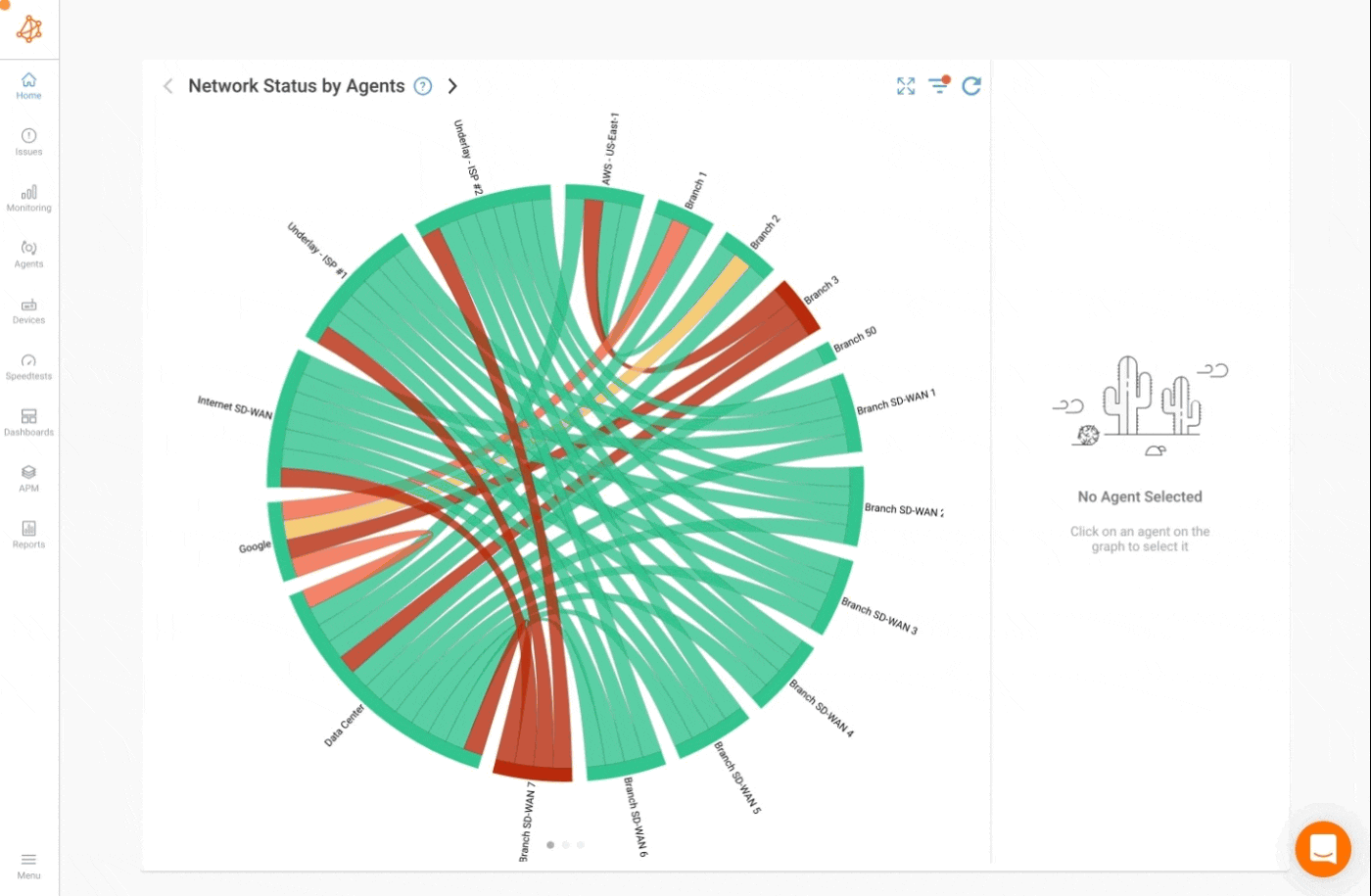

In the intricate game of connectivity, ISP network monitoring involves delving deep into critical network metrics that unravel the secrets of performance, reliability, and security. These metrics not only help to monitor the performance of the ISP network but also assess the efficiency of the ISP's service towards the client networks.
Ready to unveil the significance of these metrics? Let's dive in!
- Latency: Delay in data transmission between two points on a network. High latency leads to sluggish response times.
2. Packet Loss: Loss of data packets during transmission. Excessive packet loss indicates potential retransmissions, impacting ISP network performance.
Jitter: Measures variability in packet delay. Crucial for smooth data transmission, especially in real-time applications.
Bandwidth Utilization: Tracks the amount of data transmitted versus network capacity. Identifies congestion and aids in planning upgrades.
Network Traffic: Analyzing volume and patterns to identify peak usage, bottlenecks, and performance-affecting trends.
Device Health: Regular monitoring of network devices for smooth operation. Utilize SNMP Monitoring or Network Device Monitoring for comprehensive oversight.
Application Performance: Tracking responsiveness and efficiency for a positive user experience and effective troubleshooting.
Uptime and Downtime: Metrics measuring network availability. Crucial for reliability checks and identifying areas for improvement.
Response Time: Time taken for a system or application to respond to a request.Slow response times affect user productivity.
Throughput: Measures the amount of data transmitted over the network in a given time. Impacts network capacity and overall network performance.
DNS Resolution Time: Monitoring to ensure efficient web browsing and application access.
CPU and Memory Usage: Keeping an eye on resource utilization to identify potential performance bottlenecks.
Error Rates: Tracking error rates for a health check of hardware and early issue identification.
Quality of Service (QoS): Ensures critical applications receive the necessary resources through traffic prioritization.
These metrics empower ISPs with a holistic perspective on network performance. By anticipating issues, optimizing resources, and ensuring top-notch service, ISPs can elevate the user experience for their clients.
Quick Tip: Monitor bandwidth usage on key links, including IP Transit, Peering, CDN links, or inter-region links. Track network performance metrics (packet loss, latency, and jitter) from all PoPs towards PoPs, the Internet, and VIP clients.
Learn how to measure network performance with key network metrics like throughput, latency, packet loss, jitter, packet reordering and more!
Learn more

New trends in ISP network performance monitoring have emerged in recent years as a result of technological advancements and modifications in how businesses use networks. Now let's examine some of the major developments in ISP network performance monitoring and how these are influencing how businesses handle this type of data collection.
Cloud-Based Apps: Businesses of all sizes are increasingly utilizing cloud-based apps. To appropriately monitor cloud-based apps, ISPs now also need to use SaaS or cloud-based network performance monitoring solutions.
End-to-End Network Visibility: Organizations seeking to obtain insight into ISP network performance at every layer of the network stack are placing an increasing emphasis on network visibility. This makes us more dependent on monitoring programs that keep an eye on every network site from WAN to LAN.
Adoption of Distributed Networks: Traditional centralized architectures are being replaced by distributed networks. This is because distributed networks are more suited to handle the growing demand for SaaS programs and cloud-based services. Distributed ISP network performance monitoring tools are therefore becoming more crucial.
Real-Time Network Analytics: As ISPs strive to obtain instantaneous insights into their network performance and promptly address problems, real-time network analytics are becoming increasingly crucial.
Wi-Fi Performance Monitoring: As Wi-Fi networks are used increasingly often in business and residential settings, Wi-Fi Performance Monitoring is becoming more crucial for Internet providers.
Artificial Intelligence and Machine Learning: To automate ISP network performance monitoring duties and provide real-time insights into network performance, artificial intelligence (AI) and machine learning (ML) are being deployed.
Focus on Security: ISP network performance monitoring with a security focus is becoming more crucial as businesses try to identify and address security issues instantly, also offering cybersecurity as a value-added service.
The Internet of Things (IoT): Tools for ISP network performance monitoring that can manage the large number of devices and data produced by IoT devices are becoming increasingly necessary as a result of the Internet of Things.
The Rollout of 5G Networks: Tools for monitoring ISP network performance that can keep track of the higher latency and bandwidth requirements of 5G networks are becoming more and more necessary as these networks roll out.
Software-Defined Networking (SDN): The management and monitoring of networks are changing due to SDN, requiring the development of new tools and methods for ISP network performance monitoring.
In light of these advancements, it's time to bid farewell to traditional ISP performance monitoring software that is clunky and offers limited possibilities. Embrace a modern solution that serves as a catalyst for your ISP business growth, allowing you to navigate the ever-changing landscape of internet services with agility.
Look no further than Obkio, a cutting-edge Network Performance Monitoring tool designed to meet the dynamic demands of the industry, providing a seamless and efficient approach to ISP performance monitoring.

Incorporating the recommendations outlined in this article about ISP performance monitoring is not just about managing networks, it's about transforming the very fabric of your operations. When ISPs implement these laid-out steps, it translates into reduced downtime, enhanced network security, and a network that can gracefully accommodate growth.
Let’s conclude that network administrators CAN navigate the complexities of ISP networks with ease, ensuring not only smoother operations but, more importantly, the satisfaction of their customers. Happy customers, in turn, become brand advocates, driving growth through positive word-of-mouth. The commitment to providing a reliable and efficient Internet experience positions your ISP as a trusted partner in the digital journey of your users.
Ready to elevate your ISP network monitoring and performance?



























 Obkio Blog
Obkio Blog






